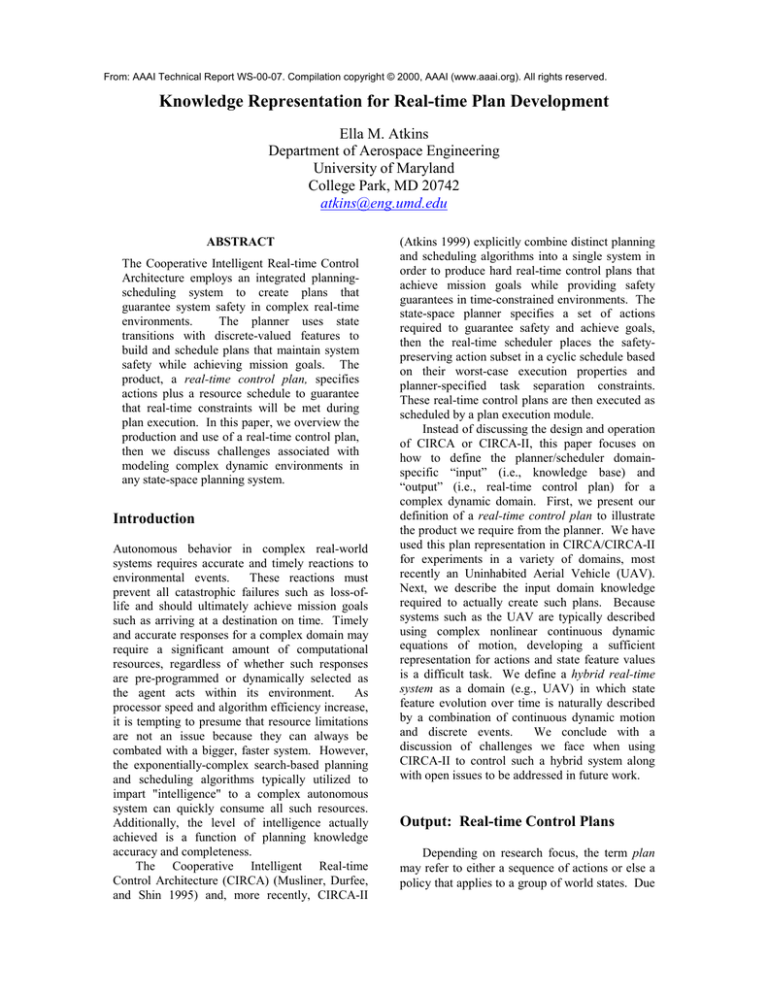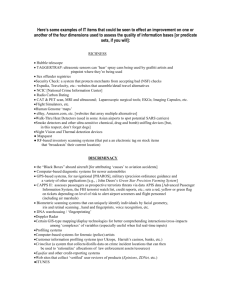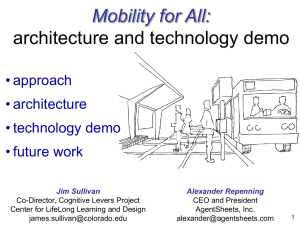
From: AAAI Technical Report WS-00-07. Compilation copyright © 2000, AAAI (www.aaai.org). All rights reserved.
Knowledge Representation for Real-time Plan Development
Ella M. Atkins
Department of Aerospace Engineering
University of Maryland
College Park, MD 20742
atkins@eng.umd.edu
ABSTRACT
The Cooperative Intelligent Real-time Control
Architecture employs an integrated planningscheduling system to create plans that
guarantee system safety in complex real-time
environments.
The planner uses state
transitions with discrete-valued features to
build and schedule plans that maintain system
safety while achieving mission goals. The
product, a real-time control plan, specifies
actions plus a resource schedule to guarantee
that real-time constraints will be met during
plan execution. In this paper, we overview the
production and use of a real-time control plan,
then we discuss challenges associated with
modeling complex dynamic environments in
any state-space planning system.
Introduction
Autonomous behavior in complex real-world
systems requires accurate and timely reactions to
environmental events.
These reactions must
prevent all catastrophic failures such as loss-oflife and should ultimately achieve mission goals
such as arriving at a destination on time. Timely
and accurate responses for a complex domain may
require a significant amount of computational
resources, regardless of whether such responses
are pre-programmed or dynamically selected as
the agent acts within its environment.
As
processor speed and algorithm efficiency increase,
it is tempting to presume that resource limitations
are not an issue because they can always be
combated with a bigger, faster system. However,
the exponentially-complex search-based planning
and scheduling algorithms typically utilized to
impart "intelligence" to a complex autonomous
system can quickly consume all such resources.
Additionally, the level of intelligence actually
achieved is a function of planning knowledge
accuracy and completeness.
The Cooperative Intelligent Real-time
Control Architecture (CIRCA) (Musliner, Durfee,
and Shin 1995) and, more recently, CIRCA-II
(Atkins 1999) explicitly combine distinct planning
and scheduling algorithms into a single system in
order to produce hard real-time control plans that
achieve mission goals while providing safety
guarantees in time-constrained environments. The
state-space planner specifies a set of actions
required to guarantee safety and achieve goals,
then the real-time scheduler places the safetypreserving action subset in a cyclic schedule based
on their worst-case execution properties and
planner-specified task separation constraints.
These real-time control plans are then executed as
scheduled by a plan execution module.
Instead of discussing the design and operation
of CIRCA or CIRCA-II, this paper focuses on
how to define the planner/scheduler domainspecific “input” (i.e., knowledge base) and
“output” (i.e., real-time control plan) for a
complex dynamic domain. First, we present our
definition of a real-time control plan to illustrate
the product we require from the planner. We have
used this plan representation in CIRCA/CIRCA-II
for experiments in a variety of domains, most
recently an Uninhabited Aerial Vehicle (UAV).
Next, we describe the input domain knowledge
required to actually create such plans. Because
systems such as the UAV are typically described
using complex nonlinear continuous dynamic
equations of motion, developing a sufficient
representation for actions and state feature values
is a difficult task. We define a hybrid real-time
system as a domain (e.g., UAV) in which state
feature evolution over time is naturally described
by a combination of continuous dynamic motion
and discrete events.
We conclude with a
discussion of challenges we face when using
CIRCA-II to control such a hybrid system along
with open issues to be addressed in future work.
Output: Real-time Control Plans
Depending on research focus, the term plan
may refer to either a sequence of actions or else a
policy that applies to a group of world states. Due
State-i
start
State-k
State-j
Action-1
...
Action-1
State-l
Action-2
State-n
Action-2
State-m
...
...
...
...
Action-m
State-x
Action-n
State-z
State-y
...
finish
a) STRIPS Plan.
b) MDP Policy.
Figure 1: Traditional Plan Types.
Test1-1,
Test1-1(feature_subset)
Test1-2(feature_subset)
…
Action-1
guaranteed
Action-1
TAP1 Test1-2, …
Test2-1,
TAP2 Test2-2, …
Action-2
Test3-1,
TAP3 Test3-2, …
Test2-1(feature_subset)
Test2-2(feature_subset)
…
Action-2
Test5-1,
TAP5 Test5-2, …
Test4-1,
TAP4 Test4-2, …
Action-5
Test6-1,
TAP6 Test6-2, …
...
Action-3
Action-4
Action-6
...
Test7-1,
Action-7
TAP7 Test7-2, …
Testn-1(feature_subset)
Testn-2(feature_subset)
…
best-effort
Action-n
Cyclic
Schedule: 0
a) “Minimized-Precondition” Policy.
TAP1
TAP2 TAP3
1
3
2
4
5
TAP2
6
7
8
TAP1
9
TAP2 TAP4
TAP2
10 11 12 13 14 15 16
b) Hard-real-time Control Plan.
Figure 2: Evolution of the Real-time Control Plan.
to our veritable obsession with hard real-time plan
execution, our plans must include more than
constructs for matching actions to states. Figure 1
illustrates two of the most popular interpretations
of a plan. Figure 1a shows a STRIPS plan (Fikes
and Nilsson, 1987), a sequential action format
produced by many popular state-space and planspace systems. This specification is appropriate
when actions may always be executed in a
predefined sequence. The STRIPS plan structure
does not rely on active sensing during plan
execution, implying there can be no uncertainty
about when or in what order actions should
execute.
Figure 1b illustrates a policy
representation such as that generated by a
traditional Markov Decision Process (MDP)
(Boutilier, Dean, and Hanks, 1999). In this
model, there is uncertainty regarding the exact
progression of states that will be encountered, so
the set of current state features must be sensed and
matched to the correct action to execute next. As
a result, reaction times to environmental events
are a function of the total time required to identify
the current state, find the appropriate action, then
execute that action.
Because the progression of world states may
not be known during offline plan development, a
real-world plan execution system may require
state feature sensing to select appropriate actions.
However, dynamic and dangerous environments
also require that the complete sense-act loop
execute in hard real-time to guarantee failureavoidance. To define our notion of real-time
control plan, consider an MDP policy as the initial
representation.
Now, to increase execution
efficiency for matching the current world state to
the correct policy action, consider a new format in
which the policy is post-processed so that a set of
general "preconditions", not fully-instantiated
states, is used to uniquely match each reachable
state to a policy action during plan execution.
This
"minimized
precondition"
policy
representation is shown in Figure 2a.1
In a policy where the exact sequence of states
cannot
be
predicted,
the
"minimizedpreconditions" for executing each action must be
checked periodically, with each action executing
whenever its preconditions match. Otherwise, the
action may never execute in a state where it has
been planned. This plan structure suggests a loop
over the precondition-action pairs to identify and
execute the proper action for each state. A cycle
through the plan-loop will not execute
instantaneously, so we must structure the plan so
that each action's preconditions will be tested with
sufficient frequency to guarantee avoiding any
failures that might occur should action execution
delay too long.
If all actions are required for failureavoidance and all actions have the same real-time
execution deadlines for failure-avoidance, then the
best we could do is to cycle through the plan-loop
as-is. However, typically, only certain actions are
required for failure-avoidance while others are
used only for goal-achievement. We attach to
each action the worst-case timing requirements for
guaranteed failure-avoidance, and classify all
actions with specified worst-case timings as
"guaranteed" while all others are "best-effort", as
illustrated in Figure 2b. Now, if all guaranteed
actions have the same worst-case timing
requirements, we can execute the "plan-loop" over
all guaranteed actions, inserting best-effort actions
into slack time intervals when available.
However, in general, the guaranteed actions may
have a very diverse set of real-time requirements.
Thus, instead of looping over each action in the
guaranteed set, we may maximize our ability to
guarantee that all execute in time by explicitly
scheduling these actions in accordance with their
resource requirements and real-time deadlines.
Figure 2b includes a cyclic schedule that
specifies the "plan-loop" for the set of guaranteed
actions for this plan. We define a task as the
combination of the minimized-precondition
feature tests for the action as well as the action
itself. For guaranteed performance, this schedule
must be built assuming worst-case task resource
consumption, and must verify that all real-time
constraints for the associated action will be met
during execution. In CIRCA and CIRCA-II, we
define a real-time control plan as the Figure 2b
combination of a minimized-precondition task set
and cyclic task schedule that guarantees real-time
failure-avoidance during plan execution.
Input: Knowledge Base
The primary reason to create a real-time control
plan is to guarantee safe operation while a
system/vehicle interacts with a dangerous,
dynamic environment. Generally, AI planners are
defined by the search strategies and heuristics
employed to develop plans. Ultimately, however,
plan quality is a function of domain knowledge
accuracy and completeness.2
For traditional
planners, a knowledge base contains a set of
discrete state features and values along with
transitions that describe how the world changes as
actions are executed. A large but finite set of
world states may be enumerated from this
information, and associated transitions provide a
simple mechanism for describing discrete events
(e.g., (STACK A B) from the “Blocks World”
(Russell and Norvig, 1995)). This state-space
representation has been adopted by planning
researchers and has led to systems that reason
efficiently about complex high-level tasks and
their interactions.
CIRCA and CIRCA-II adopt this basic model
for encoding domain knowledge and include
transitions to describe both controlled actions and
exogenous events. Due to its focus on real-time
issues, a CIRCA knowledge base also contains
1
The decision-tree-based minimal precondition
generation algorithm in CIRCA and CIRCA-II prevents
the existence of multiple choice points for all states
expanded during planning. All other “unexpected”
states are identified during plan execution as described
in (Atkins, 1999).
2
This statement holds for static and dynamic (i.e.,
learned) knowledge, given that plan quality may change
over time as new experiences are integrated.
transition timing information, including delays3
before exogenous events may occur and delays
between initiating an action and the associated
state change. This information along with worstcase
action
execution
properties
allow
development of the real-time control plans
described above.
Hybrid Systems for Plan Development
Real-time agents typically move within their
environment, either on the Earth’s surface (e.g.,
office robot, automobile) or in three-dimensional
space (e.g., UAV). Such motion is inherently
continuous in nature, but symbolic planning
researchers have discovered clever ways of
circumventing this problem. For example, A*
search during route planning (Russell and Norvig,
1995) allows identification of the shortest path
from a location A to location B. The key to the
“shortest route” search problem is the existence of
a “road map” to define route segments (i.e.,
actions) and their associated distances and
traversal times (i.e., costs).
Figure 3: Excerpt from an IFR Flight Chart.
3
Transition delays are specified statistically in
CIRCA-II.
We have taken an analogous approach in
CIRCA-II.
For UAV simulations, we have
extrapolated the “road map” idea to IFR
(Instrument Flight Rules) flight routes. Figure 3
shows an IFR chart for the Miami area, with route
segments connecting circled “waypoints”.
Unfortunately, many systems operate in
environments where clearly-defined routes are not
available. For example, off-road driving makes
traditional road maps irrelevant, and the upcoming
transition to aircraft “free-flight” will limit the
utility of IFR charts for route planning. To-date,
we have either specified a choice of routes for the
CIRCA planner (e.g., segments from an IFR flight
chart) or else ignored the routing problem
completely (e.g., specified action “go to location
x” without deeper investigation). If specific
routing details are not required at the state-space
planning level (e.g., “go to destination x” is
sufficient), then a separate trajectory generation
module can be used to supplement the planner.
This module would take as input proposed start
and destination locations, and would feed back a
trajectory, minimum transit time, and maximum
resource consumption required for that path. In
this fashion, complete real-time plans are
developed. This method is desirable because it
allows the planner to exclusively reason about its
area of expertise: discrete events, including fixed
initial and goal destinations (e.g., airports). The
use of a dynamics-based trajectory generator is
also attractive because it allows tractable
consideration of continuous operating regions
(e.g., aircraft free-flight) rather than predetermined fixed routes.
Although a good first step, we believe this
simple combination is not generally sufficient for
autonomous vehicle operation, specifically in
situations where the precise path between initial
and destination locations is relevant for high-level
deliberation. For example, consider a UCAV
(Uninhabited Combat Aerial Vehicle) mission in
which the “goal destination” is a missile target,
along with additional goal of aircraft survival.
Combat survival involves evading enemy
weapons when required (e.g., with aggressive
maneuvers) followed by a return to the nominal
goal path, as was demonstrated with CIRCA-II in
simulation (Atkins, 1999). However, survival
following battle damage requires knowledge of
the degree to which the UCAV can still fly. As a
simple example, consider damage that results in
engine failure. In this situation, the UCAV will
most likely be unable to reach its goal, thus an
alternate trajectory based on “best reachable
emergency landing site” must be computed. The
continuous variable values representing aircraft
best glide ratio, altitude, airspeed, etc. are required
to determine the subsequent contingency plan, and
the overall “goal” switches from a specific
destination to selecting and landing safely at a
“reachable” destination. However, the planner
does not have sufficient knowledge to distinguish
between reachable and unreachable goal
destinations without a more information about
vehicle dynamics.
Conversely, the basic
trajectory generator can determine whether any
particular site is “reachable” but does not have the
knowledge to select “desirable” versus
“undesirable” goal destinations.
To address such a situation, we are working
to develop a more tightly integrated symbolic
planning — trajectory generation approach.
Recently, hybrid systems researchers (Egerstedt
et. al.) with roots in the controls community have
adopted finite state automata for discrete events
along with dynamics-based trajectory generation
algorithms to effectively develop and follow paths
from initial to goal locations. Because such
systems were developed from the “bottom up”
(i.e., dynamics controller trajectory
generation reactive finite automata), the bulk of
research to-date has employed a set of mode
switch transitions to define how the trajectory
should be generated, and goal destinations are
either fixed or else generated implicitly by
potential field maps. By using the fundamental
equations of motion, route segment shapes and
traversal times are easily recomputed as vehicle
dynamics (e.g., maximum engine power/thrust)
and environmental properties (e.g., mud depth for
off-road driving) change. We believe the finite
automata currently used by trajectory generation
experts will guide us in the direction of a more
expressive symbolic planning – trajectory
generation interface, and we hope to incorporate
such techniques as tools for next-generation
planning algorithms.
References
E. M. Atkins, “Plan Generation and Real-time
Execution with Application to Safe, Autonomous
Flight,” Ph.D. Dissertation, University of
Michigan, 1999.
C. Boutilier, T. Dean, and S. Hanks, “DecisionTheoretic Planning: Structural Assumptions and
Computational Leverage,” Journal of Artificial
Intelligence Research (JAIR), 11(1999) 1-94.
M. Egerstedt, T. Koo, F. Hoffmann, and S. Sastry.
“Path Planning and Flight Controller Scheduling
for an Autonomous Helicopter,” in Hybrid
Systems: Computation and Control, Lecture
Notes in Computer Science 1569, SpringerVerlag, Berkeley, CA, 1999.
R. E. Fikes and N. J. Nilsson, “STRIPS: A New
Approach to the Application of Theorem Proving
to Problem Solving,” Artificial Intelligence 2(34)(1971) 189-208.
D. J. Musliner, E. H. Durfee, and K. G. Shin,
“World Modeling for the Dynamic Construction
of Real-Time Control Plans,” Artificial
Intelligence, 74(1) (1995) 83-127.
S. Russell and P. Norvig, Artificial Intelligence:
A Modern Approach, Prentice-Hall, Englewood
Cliffs, New Jersey, (1995).





